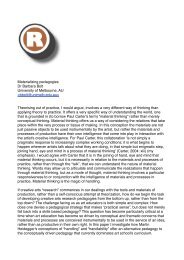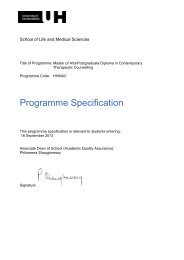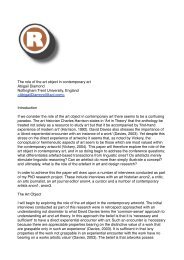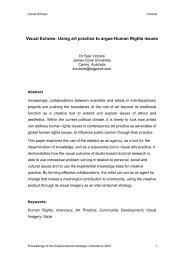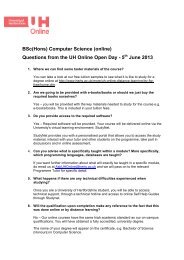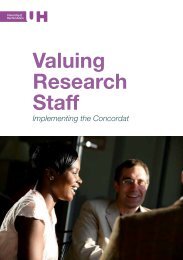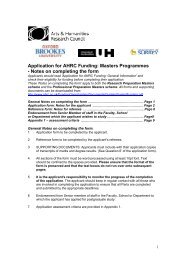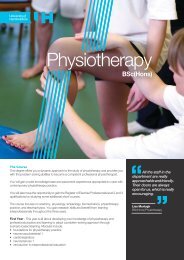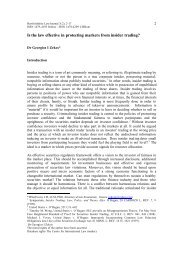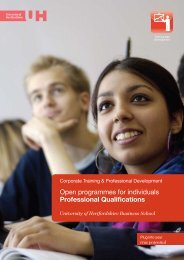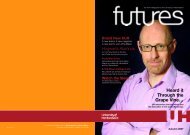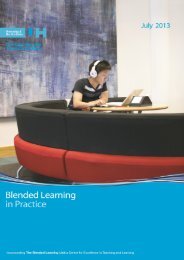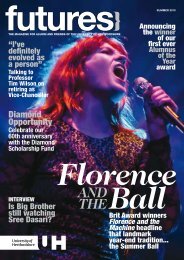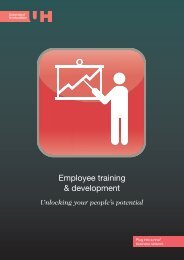June 2009 - University of Hertfordshire
June 2009 - University of Hertfordshire
June 2009 - University of Hertfordshire
You also want an ePaper? Increase the reach of your titles
YUMPU automatically turns print PDFs into web optimized ePapers that Google loves.
Senior lecturer to assessor...<br />
41<br />
encourage students to think deeply about their answer and self reflect on their own<br />
reasoning following Nicol and MacFarlane-Dick‟s (2006) feedback principles <strong>of</strong> self<br />
reflection/assessment and motivation. MRQ design takes time and can be problematic if<br />
answers are not necessarily completely true or false, especially when we are trying to<br />
teach our future scientists that there is rarely a single correct answer to a given problem,<br />
although this is more applicable in the final year when MRQs are not used. Nicol (2007)<br />
discusses how MRQs can be used to enhance learning by manipulating the context within<br />
which these tests are used. In the School <strong>of</strong> Life Sciences electronic voting systems are<br />
now an integral part <strong>of</strong> the first year undergraduate student learning environment;<br />
students respond to MCQs using their own handset and the responses inform the teacher<br />
to adapt teaching to students needs. This might include a recap <strong>of</strong> some <strong>of</strong> the lecture,<br />
provision <strong>of</strong> MCQs as preparatory work, peer instruction to work in groups to discuss with<br />
one another whether or not they have the correct answer („just in time teaching‟ Novak et<br />
al., 1999). Furthermore, one way to include MRQs in final year undergraduate<br />
assessments would be to base MRQs or CBM on case studies or research papers for<br />
data interpretation and critique purposes, or to task students to construct MRQs that<br />
encourage peer assessment (Fellenz, 2004).<br />
Essay questions are perhaps more appropriate for second year undergraduates, as they<br />
measure higher level cognitive skills such as collating and critiquing new ideas or<br />
theories, all essential skills for a pr<strong>of</strong>essional scientist. There are limitations however,<br />
since it may be difficult to permit enough essay questions in the time frame to cover the<br />
entire module content. As Biggs (2003) describes, students will always second guess the<br />
assessment task, and then learn what they think will meet those requirements, i.e. revise<br />
only the topics they need to (Biggs 2003). Essay questions also need to be carefully<br />
worded for the appropriate level (Bloom, 1956; Biggs and Collis 1982) and to ensure the<br />
question is unambiguous and therefore interpreted in the same way by all students.<br />
Conclusion<br />
Previously many teachers may have focused on teaching, assuming students are skilled<br />
at learning activities such as note-taking, researching, essay writing and revision. It is<br />
clear we need to involve students as much as possible with assessment in order to<br />
provide them with the student-lecturer interaction that they request (Time Higher Student<br />
Experience Survey, <strong>2009</strong>) as well as to enhance their learning.<br />
This reflective account has considered the differences in assessment for a specific<br />
module at second year undergraduate level in the Biosciences programme at the<br />
<strong>University</strong> <strong>of</strong> <strong>Hertfordshire</strong>. There was a clear balance <strong>of</strong> unseen examination and<br />
coursework within this new undergraduate module in line with the Biosciences<br />
programme. Coursework increases the assessment load for lecturers but provides a<br />
reliable assessment <strong>of</strong> student capabilities over time as well as the continual opportunity<br />
for detailed feedback for learning. In contrast, unseen examinations eliminate plagiarism,<br />
but encourages rote learning (Entwhistle, 1984), favouring those students that perform<br />
better under acute stress but <strong>of</strong>ten narrowing the range <strong>of</strong> learning outcomes that can be<br />
measured, particularly in the case <strong>of</strong> essay questions. Increasing the use <strong>of</strong> different<br />
Blended Learning In Practice <strong>June</strong> <strong>2009</strong>



